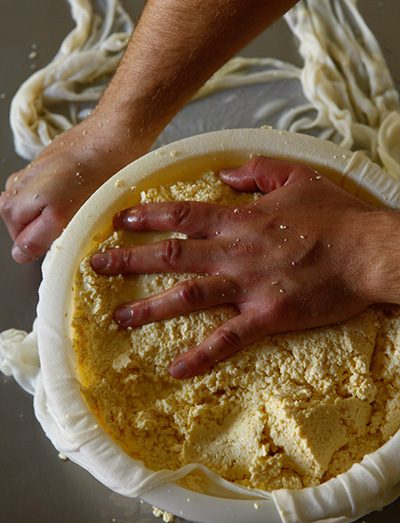
Cherry Grove Farm and Creamery, Lawrenceville
Staring at the contents of six test tubes, Sam Kennedy looks more like a chemist than a cheesemaker. In fact, as much as food artisanship involves old-fashioned labor and earthy ingredients, it also requires scientific precision—especially in the art of cheese making.
Today, Kennedy—at age 28, Cherry Grove’s head cheese maker—is making Herdsman, the company’s most popular all-purpose and kid-friendly cheese. He is seated at a control panel in a sterile room inside a 19th-century barn. A few feet away, 200 gallons of fresh milk from some of Cherry Grove’s 100 Shorthorn and Jersey cows are being heated and stirred in a mechanized, stainless steel vat.
The cows come indoors twice a day to be milked. Otherwise they roam 230 acres of pasture, feasting on organic grasses chosen for their digestability and high levels of vitamins, minerals and beta carotene, producing a rich, pale-yellow milk.
To make sure the milk becomes mild, nutty, cheddar-like Herdsman, and not a flavor or texture deviant, Kennedy hawkishly monitors the pH, or acidity level, in the vat. When the milk reaches 80 degrees, he fills the first test tube. After a bacterial culture is added to ripen, or acidify, the milk, he fills a second test tube. He samples again after rennet is added to help coagulate the milk into semisolid curds and watery whey. He takes three more whey samples as the coagulating goo is raised to 102 degrees, rested and finally drained of liquid, the whey to be fed to Cherry Grove’s pigs.
“If the acidity builds up too fast,” Kennedy says, “if the temperature in my room is too warm and creates over-fermentation, you end up with something that’s not [right].” Too much acidity? Dry, crumbly cheese. Too little? A cheese with huge bubbles (called eyes) that implode turning the cheese bricklike. Even slight variations from optimal pH and temperature are to be avoided. “It might not be bad,” Kennedy says, “but it’s not what you know as Cherry Grove Farm cheese.”
It is still ridiculously early in the life cycle of Herdsman. The soft curds are hand packed into cloth-lined, wheel-shaped plastic molds that go into a hydraulic press for three hours to squeeze out air and residual whey. Following an overnight rest, the molds are removed and the nascent wheels spend 30 hours submerged in strong brine to introduce a touch of salty flavor and secondarily to extract more moisture and kill bacteria. Enzymes form that cause the cheese to deepen in color and flavor during its ensuing five-month slumber in the aging room. Even there the wheels are not left alone. For the first two months, surface mold is patted down and the wheels turned twice a week. After that, they are turned once a week.
“So many variables go into cheese making,” Kennedy says, “that even on day 159, something can go wrong.”
A native of Hamilton, Kennedy was finishing his degree at the Culinary Institute of America when, in 2005, on a visit to California, he spent time with a Sonoma cheese maker and came back jazzed about the craft. After graduating the next year, he worked in corporate kitchens and at Rats Restaurant in Hamilton. But when an opportunity to help run Cherry Grove became available in 2009, he grabbed it. Hired full-time in January 2011, he was named head cheese maker that August.
The family that owns Cherry Grove, the Hamills—currently represented by brothers Bill, Sam and Oliver—relocated from Pennsylvania to Lawrenceville in the early 1800s and have owned the land where the farm sits since 1910. Cherry Grove also raises sheep and pigs. The butchered meat is sold at the farm store, alongside fresh eggs from the farm’s own hens, and eight to ten cheeses. Visitors can bring kids to the petting paddock, watch cheese being made, or catch cow milking at approximately 5 am and 5 pm.
Last year, Cherry Grove produced close to 50,000 pounds of cheese, an amount that giant national brands can turn out in a single day. In the fall, Scott Green, corporate executive chef of the Salt Creek Grille organization, which has restaurants in Rumson and Princeton and three in California, sat down with Kennedy to taste the creamery’s full line of more than a dozen cheeses. He decided to add Buttercup brie and Toma, a washed-rind raw-milk cheese that is the farm’s best seller, to the popular cheese platters at Salt Creek’s Jersey restaurants.
“I love being able to tell a story at the table, especially with something as intricate as a cheese plate,” Green said, noting that he would urge his waiters to do exactly that. “It’s a real craft, what you do here, and not something you find very often. I have a ton of respect for it.”
That pleases Kennedy enormously. “One thing New Jersey does well is grow grass, and making good cheese is all based around pasture-raised animals,” he says. “There’s nothing in New Jersey to limit that potential.” 3200 Lawrenceville Rd, 609-219-0053, cherrygrovefarm.com
Click here to read more about homegrown New Jersey foods.
